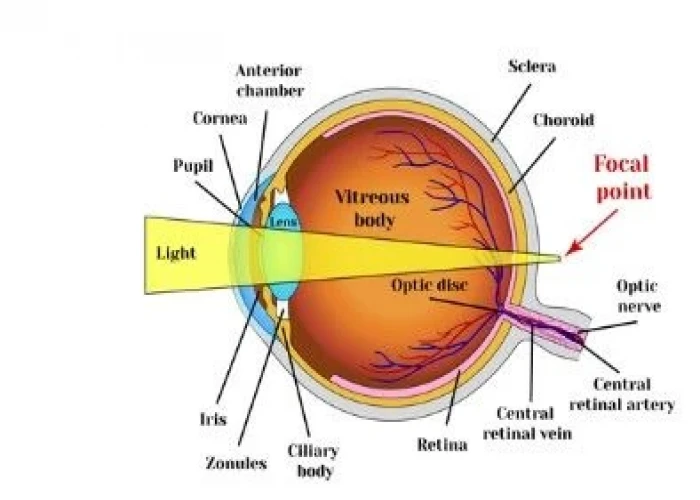 Welcome
Welcome
“May all be happy, may all be healed, may all be at peace and may no one ever suffer."
Presbyopia

Presbyopia is a common age-related eye condition that affects the ability to see objects up close. It occurs when the lens of the eye becomes less flexible and cannot change shape as easily as it did in younger years, making it harder to focus on close objects.
Presbyopia typically becomes noticeable around the age of 40 and affects nearly everyone at some point in their lives. The symptoms of presbyopia include difficulty reading small print, eyestrain, headaches, and the need to hold reading materials farther away.
The most common treatment for presbyopia is wearing reading glasses or bifocal/multifocal glasses or contact lenses. These lenses can help compensate for the inability of the eye to focus on close objects. Refractive surgery, such as LASIK or other types of corrective eye surgery, can also be used to correct presbyopia.
In addition to corrective lenses or surgery, there are several other strategies that can help manage presbyopia symptoms, such as increasing the amount of light in the environment, taking frequent breaks when reading or using a computer, and practicing good eye hygiene, such as regularly cleaning contact lenses and avoiding eye strain.
It is important for anyone experiencing changes in their vision to have a comprehensive eye exam to rule out any other underlying conditions that may be causing the symptoms.
Research Papers
Disease Signs and Symptoms
- Blurred vision of eye
- Headaches
- Blindness (Vision loss)
- Eye pain or burning
- Double vision (diplopia)
- A tendency to hold reading material farther away to make the letters clearer
- Eyestrain or headaches after reading or doing close-up work
Disease Causes
Presbyopia
To form an image, your eye relies on the cornea and the lens to focus the light reflected from objects. The closer the object, the more the lens flexes.
- The cornea is the clear, dome-shaped front surface of your eye.
- The lens is a clear structure about the size and shape of an M&M's candy.
- Both of these structures bend (refract) light entering your eye to focus the image on the retina, located on the inside back wall of your eye.
The lens, unlike the cornea, is somewhat flexible and can change shape with the help of a circular muscle that surrounds it. When you look at something at a distance, the circular muscle relaxes. When you look at something nearby, the muscle constricts, allowing the relatively elastic lens to curve and change its focusing power.
Presbyopia is caused by a hardening of the lens of your eye, which occurs with aging. As your lens becomes less flexible, it can no longer change shape to focus on close-up images. As a result, these images appear out of focus.
Disease Prevents
Disease Treatments
The goal of treatment is to compensate for the inability of your eyes to focus on nearby objects. Treatment options include wearing corrective eyeglasses (spectacle lenses) or contact lenses, undergoing refractive surgery, or getting lens implants for presbyopia.
Eyeglasses
Eyeglasses are a simple, safe way to correct vision problems caused by presbyopia. You may be able to use over-the-counter (nonprescription) reading glasses if you had good, uncorrected vision before developing presbyopia. Ask your eye doctor if nonprescription glasses are OK for you.
Most nonprescription reading glasses range in power from +1.00 diopter (D) to +3.00 D. When selecting reading glasses:
- Try different powers until you find the magnification that allows you to read comfortably, starting with the lower powers
- Test each pair on reading material held at a comfortable distance
You'll need prescription lenses for presbyopia if over-the-counter glasses are inadequate or if you already require prescription corrective lenses for nearsightedness, farsightedness or astigmatism. Your choices include:
- Prescription reading glasses. If you have no other vision problems, you can use glasses with prescription lenses for reading only. You will need to remove these when you're not reading.
- Bifocals. These lenses have a visible horizontal line that separates your distance prescription, above the line, and your reading prescription, below the line.
- Trifocals. These glasses have corrections for close-up work, middle distance vision — such as for computer screens — and distance vision. Trifocals come with two visible horizontal lines in the lenses.
- Progressive multifocals. This type of lens has no visible horizontal lines, but has multiple powers for distance, middle distance and close-up corrections. Different areas of the lens have different focusing strengths.
- Office progressives. These lenses have corrections for computer-distance and close work. You generally use these at a computer or for reading and remove them for driving or walking around.
Contact lenses
People who don't want to wear eyeglasses often try contact lenses to improve their vision problems caused by presbyopia. This option may not work for you if you have certain conditions related to your eyelids, tear ducts or the surfaces of your eyes such as dry eye.
Several lens types are available:
- Bifocal contact lenses. Bifocal contact lenses provide distance and close-up correction on each contact. In one type of bifocal lens, the bottom, reading portion of the lens is weighted to keep the lens correctly positioned on your eye. Newer types of bifocal contact lenses offer one type of correction through the edges (periphery) of each lens and the other type of correction through the center of the lenses.
- Monovision contact lenses. With monovision contacts, you wear a contact lens for distance vision in one eye (usually your dominant eye) and a contact lens for close-up vision in the other eye.
- Modified monovision. With this option, you wear a bifocal or multifocal contact lens in one eye and a contact lens set for distance in the other (usually your dominant eye). You use both eyes for distance and one eye for reading.
Refractive surgery
Refractive surgery changes the shape of your cornea. For presbyopia, this treatment can be used to improve close-up vision in your nondominant eye. It's like wearing monovision contact lenses. Even after surgery, you may need to use eyeglasses for close-up work.
Talk with your doctor about the possible side effects, as this procedure is not reversible. You might want to try monovision contact lenses for a while before you commit to surgery.
Refractive surgical procedures include:
- Conductive keratoplasty. This procedure uses radiofrequency energy to apply heat to tiny spots around the cornea. The heat causes the edge of the cornea to shrink slightly, increasing its curve (steepness) and focusing ability. The results of conductive keratoplasty are variable and may not be long lasting.
- Laser-assisted in situ keratomileusis (LASIK). With this procedure, your eye surgeon cuts a thin, hinged flap away from the front of your eye. He or she then uses a laser to remove inner layers of your cornea to steepen its domed shape.
- Recovery from LASIK surgery is usually more rapid and less painful than other corneal surgeries.
- Laser-assisted subepithelial keratectomy (LASEK). The surgeon creates an ultra-thin flap only in the cornea's outer protective cover (epithelium). He or she then uses a laser to reshape the cornea's outer layers, steepening its curve, and then replaces the epithelium.
- Photorefractive keratectomy (PRK). This procedure is similar to LASEK, except the surgeon completely removes the epithelium, then uses the laser to reshape the cornea. The epithelium is not replaced, but will grow back naturally, conforming to your cornea's new shape.
Lens implants
Some ophthalmologists use a procedure in which they remove the lens in each eye and replace it with a synthetic lens. This is called an intraocular lens.
Several types of lens implants are available for correcting presbyopia. Some allow your eye to see things both near and at a distance. Some change position or shape within the eye (accommodative lens). But lens implants can cause a decrease in the quality of your near vision, and you may still need reading glasses.
Possible side effects include glare and blurring. In addition, this surgery carries with it the same risks as those associated with cataract surgery, such as inflammation, infection, bleeding and glaucoma.
Corneal inlays
Some people have had success with a presbyopia treatment that involves inserting a small plastic ring with a central opening, into the cornea of one eye. The opening acts like a pinhole camera and allows in focused light so that you can see close objects.
If you don't like the results of your corneal inlay procedure, your eye surgeon can remove the rings, leaving you free to consider other treatment options.
Disease Diagnoses
Disease Allopathic Generics
Disease Ayurvedic Generics
Disease Homeopathic Generics
Disease yoga
Presbyopia and Learn More about Diseases

Tularemia

Depersonalization-derealization disorder

Childhood obesity

Pseudobulbar affect

Nail fungus

Traumatic brain injury

Gastroesophageal reflux disease (GERD)

Sick sinus syndrome
presbyopia, প্রিজবায়োপিয়া
To be happy, beautiful, healthy, wealthy, hale and long-lived stay with DM3S.
